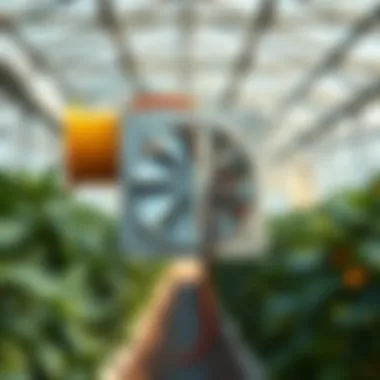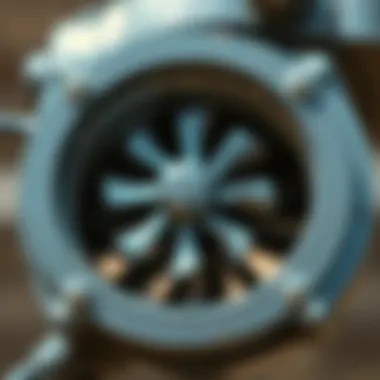Essential Guide to Exhaust Fans with Shutter in Agriculture


Intro
In the world of agriculture, the delicate balance of air quality and temperature can mean the difference between a bountiful harvest and a disappointing yield. This is where exhaust fans with shutters come into play. These systems are not just a luxury; they are essential for maintaining optimal growing conditions, especially in greenhouses and enclosed farming areas.
As farming techniques evolve and the demands on agricultural productivity increase, understanding the role of these ventilation systems becomes vital. Whether you are a seasoned farmer looking to upgrade your facilities or a hobbyist green thumb trying to achieve better results, comprehending how exhaust fans function will set the stage for improved crop outcomes.
Key Concepts and Terminology
Basic Definitions
To grasp the significance of exhaust fans in agricultural settings, it's important to define a few key terms:
- Exhaust Fans: Devices designed to move air out of a space, maintaining a fresh atmosphere by expelling stale air, humidity, and heat.
- Shutter Mechanism: A system of flaps that open and close to regulate airflow depending on the operating conditions. When the fan is off, shutters close to prevent outside air from entering, and when the fan runs, they open, allowing for maximum airflow.
- Ventilation: The process of exchanging or replacing air in a space to enhance air quality.
These definitions lay the groundwork for understanding how these components work in conjunction.
Historical Context
Historically, ventilation in agricultural practices has been a cornerstone of successful farming. Before modern fans, farmers relied heavily on natural air circulation. However, with the rise in intensive farming methods and the construction of large, enclosed structures, the need for controlled air movement became clear. The integration of mechanical exhaust systems in farming has evolved over the decades, driven primarily by the need to optimize growth conditions and improve air quality.
Recent Innovations and Trends
Technological Advancements
Recent years have seen a boom in the technology behind exhaust fans. Modern models incorporate sensors and automated controls that remotely regulate temperature and humidity. This advancement allows farmers to maintain ideal microclimates within their growing spaces without constant manual checks. Just imagine the efficiency: fans adjust automatically in response to temperature spikes, ensuring crops receive the necessary airflow.
Some companies are designing fans with energy efficiency in mind, utilizing DC motors and variable speed options to reduce energy consumption while maximizing airflow.
Sustainable Practices
As agriculture faces increasing scrutiny over its environmental impact, sustainable practices are emerging as trends. Many farmers are now integrating exhaust fans with renewable energy sources, like solar panels, which help in reducing carbon footprint and operational costs. Moreover, the use of natural materials in fan construction is on the rise. Some fans now feature composite materials that are not only durable but also eco-friendly.
Practical Applications and Techniques
Step-by-step Guides
Understanding how to effectively use exhaust fans involves several steps:
- Assess your Environment: Determine the size of the space needing ventilation and evaluate the typical climate conditions.
- Select the Right Fan: Look at the specifications regarding airflow rate, efficiency, and noise levels according to your space requirements.
- Installation: Familiarize yourself with installation manuals. Proper positioning and sealing of the fan will optimize its performance.
- Regular Maintenance: Schedule routine checks to ensure all components function correctly. Clean the blades and check the shutter mechanisms for debris or wear.
Case Studies
There are numerous examples where the installation of exhaust fans with shutters has resulted in increased productivity:
- A commercial tomato grower in California experienced a 20% yield increase after switching to automated exhaust fans with smart tech, allowing them to maintain a consistent and optimal environment for crop growth.
- A nursery in Florida found that their operating costs significantly decreased when they incorporated fans powered by solar energy, showcasing the financial advantages of eco-friendly innovations.
"Proper ventilation is not just about keeping the air moving; it’s about creating a thriving ecosystem for plants to flourish."
Preamble to Exhaust Fans with Shutter
The significance of exhaust fans equipped with shutters in agriculture is truly remarkable, serving as a cornerstone for optimal environmental control within farming and horticultural practices. These devices, often found in various agricultural setups, act as gatekeepers of air quality, helping to regulate temperature and humidity levels crucial for crop health. Their function stretches beyond merely moving air; they contribute to the overall efficiency of agricultural systems by ensuring that plants thrive in the most favorable conditions possible.
Definition and Purpose
An exhaust fan with shutter is a mechanical ventilation system designed to remove stale air from an environment, replacing it with fresh air. The shutter component plays an integral role, opening automatically when the fan operates and closing tightly when it’s off, preventing the entry of pests and outside elements. This design not only keeps the internal environment controlled but also conserves energy. The primary purpose of these fans is to maintain the delicate balance of temperature and humidity that affects crop growth, ensuring that plants receive sufficient airflow while minimizing the risk of diseases linked to stagnant air.
Importance in Agricultural Settings
In agricultural settings, exhaust fans with shutters are not just an accessory but a necessity. Poor air circulation can lead to several complications, including increased humidity, which can foster fungal growth and diseases. On the flip side, excessive heat can stress plants, slowing down their growth and reducing yield. Here are some critical points highlighting their importance:
- Temperature Management: They help remove excess heat during peak sunlight hours, ensuring that crops remain at optimal temperatures.
- Humidity Control: By drawing out warm, moist air and replacing it with cooler air, these fans play a vital role in moisture control, which is crucial in preventing mold and mildew.
- Enhanced Growth Rates: With improved air circulation, plants often exhibit better growth rates and quality, leading to a boost in overall productivity.
Moreover, by promoting a pleasant microclimate within grow rooms, barns, or greenhouses, these fans support the health of both the crops and the workers tending to them. In essence, integrating exhaust fans into agricultural practices is akin to installing a lifeline—one that can be the difference between a barren field and a bountiful harvest.
"In agriculture, the path to success often lies not just in the seeds we plant, but in the air they breathe."
Understanding how these exhaust fans operate, their specific design features, and their role in agricultural environments compels farmers and horticulturists alike to consider them essential tools in their operational arsenal.
Understanding Exhaust Fan Mechanisms
Understanding how exhaust fans operate is crucial for anyone involved in agriculture, as these simple yet effective devices play a pivotal role in maintaining the ideal climate for crops and livestock. The operations of exhaust fans stem from principles of thermodynamics and airflow mechanics, which are essential to comprehend when selecting and utilizing these tools effectively. By essentially displacing warm, stale air with cooler, fresher air, exhaust fans create a healthier environment conducive to growth and productivity. Not merely a matter of preference, understanding these mechanisms directly relates to successful agricultural practices and improved yield outcomes.
How Exhaust Fans Operate
Exhaust fans function on a basic premise: they suck hot air out of a space, creating negative pressure that draws cooler air in from outside. This operation can happen in several steps:
- Initiation of Operation: When the temperature within a structure — be it a greenhouse, barn, or poultry house — rises beyond a certain threshold, the exhaust fan begins working. Most modern models include temperature and humidity sensors, automating this process for maximum efficiency.
- Air Movement: Once powered on, the motor drives blades that rotate at high speeds. This action displaces air, pushing it out of the designated exhaust area. Consequently, the cooler air is pulled in through windows or vents placed strategically, usually at lower points in the building.
- Recirculation and Ventilation: The cycle created by the exhausting of hot air and incoming cooler air constantly refreshes the atmosphere within the space. As a result, this ventilation process helps in maintaining a balanced temperature and humidity level, essential for healthy crops or animals.
In understanding this mechanism, farmers can assess which models might best suit their agricultural operations. Knowing the fundamentals of fan speed, blade design, and overall airflow dynamics allows producers to prioritize their needs and optimize their systems.
Role of Shutters in Efficiency
Shutters play a significant part in enhancing the efficiency of exhaust fans. These mechanisms not only assist in managing airflow but also provide additional insulation benefits. The functioning of shutters can be outlined as follows:
- Prevent Backflow: When the exhaust fan is turned off, shutters close automatically, preventing any unwanted air from re-entering the barn or greenhouse. This backflow can lead to a rise in temperature and humidity levels, which can be detrimental to crops or livestock.
- Energy Efficiency: Using shutters can indirectly enhance the efficiency of exhaust fans. By minimizing the amount of unconditioned air entering or exiting the structure, farms can save on energy costs associated with heating or cooling. This energy management leads to a more sustainable farming operation over time.
- Control Over Air Exchange: Shutters can often be manually or electronically controlled, which means that a farmer can fine-tune their ventilation strategy based on current environmental conditions. Such flexibility allows for optimal humidity and temperature management.
Incorporating shutters into your exhaust fan strategy isn’t strictly about just functionality; it’s about creating a versatile, adaptable agricultural environment. With this understanding, those involved in farming can make educated decisions that align with both efficiency and sustainability.
Types of Exhaust Fans with Shutter


Understanding the types of exhaust fans is crucial for those involved in agriculture. It’s not just about moving air, but how efficiently and effectively that air is moved. Two primary categories generally surface in discussions: direct drive and belt drive, as well as manual and electrically controlled options. The choice between these various types can influence the performance and longevity of the ventilation system within an agricultural setting.
Direct Drive vs. Belt Drive
When considering the mechanisms available, direct drive fans often stand out for their simplicity and efficiency. Unlike belt drive fans, which rely on belts to transfer power from a motor to the fan blades, direct drive systems connect the motor directly to the fan. This not only reduces the number of moving parts but also minimizes maintenance needs and improves efficiency.
Pros of Direct Drive:
- Fewer Moving Parts: This results in reduced wear and tear, leading to a longer lifespan.
- Better Efficiency: Direct transfer of power means less energy is wasted, ultimately lowering energy costs.
- Compact Design: Often takes up less space, which is beneficial in tight agricultural environments.
On the flip side, belt drive fans can offer flexibility in their design. They are usually considered more versatile because they can adapt to various operational requirements by changing the belt size or speed. This flexibility allows for tailored setups according to specific agricultural applications.
Pros of Belt Drive:
- Adaptability in Speed: Farmers can adjust the airflow according to the season or type of crop.
- Cost-Effective Repairs: If a failure occurs, it might be less expensive to fix as only the belt might need replacing.
Both types have merit; thus, the choice will often depend on the specific agricultural environment and budget considerations.
Manually Operated vs. Electrically Controlled
Upon diving into control systems, the debate often revolves around manually operated versus electrically controlled exhaust fans.
Manually operated fans can be advantageous in specific settings. Farmers using these systems often appreciate their simplicity and reliability. A farmer can easily control the opening and closing of shutters using a physical mechanism, which may involve levers or cranks.
Benefits of Manual Operation:
- Lower Initial Cost: Often cheaper to purchase and install, making it an accessible option for beginner farmers.
- No Electrical Dependency: There’s no risk of failure from power outages, which is crucial in rural areas where power can be intermittent.
However, the labor intensity of having to adjust these fans manually can be seen as a disadvantage, especially during peak agricultural periods when time is precious. In contrast, electrically controlled systems can significantly streamline operations.
Advantages of Electrically Controlled Systems:
- Automated Functionality: Fan settings can be adjusted with precision through thermostats or smart systems, removing the guesswork out of ventilation requirements.
- Labor Savings: Less manual intervention means that farmers can focus on other critical tasks, enhancing overall productivity.
The key is to assess the unique needs of your agricultural operation—be it the scale, budget, or specific crop requirements. A thorough evaluation will lead to an informed decision regarding which type of exhaust fan system aligns best with your farming needs.
"Choosing the right exhaust fan system influences both efficiency and crop success. Evaluate wisely!"
By exploring these distinctions between direct drive and belt drive, as well as manually operated versus electrically controlled fans, farmers and agricultural enthusiasts can better understand the tools they have at their disposal to create optimal growing environments.
Key Benefits of Using Exhaust Fans with Shutter
Exhaust fans with shutter mechanisms serve a multifaceted purpose in agricultural settings. These devices play a crucial role in creating an optimal environment for crops and livestock, thereby enhancing productivity and sustainability. Understanding the benefits they offer not only justifies their investment but also highlights their necessity in modern agricultural practices. Below, we delve into the key advantages of using exhaust fans with shutters, examining how they contribute to temperature regulation, humidity control, and pest management.
Temperature Regulation
A primary benefit of exhaust fans with shutter is their ability to regulate temperature effectively. In farming environments where temperature peaks can jeopardize crop health, these fans serve as lifesavers. They draw out hot air from within the facility, replacing it with cooler outside air. This natural ventilation helps maintain a more stable internal climate.
Additionally, well-regulated temperatures can further enhance photosynthesis, ultimately leading to increased crop yields. Research shows that excessive heat can stress plants, leading to wilting and lower productivity. Conversely, proper temperature control keeps your crops happy and thriving, which should be every farmer's goal.
"Maintaining optimal temperatures is essential; it's not just about comfort for the plants but about maximizing yields too."
Humidity Control
Humidity can become a double-edged sword in agricultural operations. On one hand, plants need moisture to flourish; however, too much moisture can lead to various problems such as mold growth and root rot. Exhaust fans with shutters are pivotal in managing humidity levels. By facilitating proper air exchange, these fans help reduce excess moisture during humid conditions, creating a healthier atmosphere for plant growth.
This is particularly crucial in greenhouses or enclosed farming setups. In such environments, humidity tends to accumulate rapidly. Incorporating exhaust fans allows operators to control moisture levels efficiently. Alongside better crop health, maintaining the right humidity also minimizes disease risks, contributing to a more robust growing operation overall.
Pest and Disease Management
Another essential advantage of these fans lies in their role in pest and disease management. Stale and humid air creates an inviting environment for pests and pathogens, leading to potential crop devastation. Exhaust fans, by promoting an airflow that disperses stale air, can significantly reduce pests' prevalence.
Moreover, when used strategically, these fans can help control odors or volatile organic compounds (VOCs) that might attract pests. Fresh air circulation works wonders not just for crops but for maintaining the overall ecosystem within your agricultural setting. Implementing good ventilation practices can often mean the difference between a thriving operation and one that's battling infestations.
In summary, exhaust fans with shutters extend far beyond mere ventilation. They stand as a cornerstone of effective agricultural management, aiding in temperature regulation, humidity control, and pest management. With proper utilization, these devices can transform farming practices, contributing significantly to improved productivity and environmental sustainability.
Selecting the Right Exhaust Fan
Choosing the suitable exhaust fan is crucial when aiming to create an optimal agricultural environment. Not only does it affect the health of your crops, but it also influences the overall efficiency of your farming operations. Factors such as size, airflow capacity, and even energy consumption can vary widely, hence it perks the interest of farmers and horticulture enthusiasts alike. Making the right choice leads to improved air quality, better crop yield, and can even save you a pretty penny in the long run.
Size Considerations
When selecting an exhaust fan, size should be high on your list of priorities. A fan that’s either too small or overly large can compromise functionality, resulting in wasted energy and underwhelming agricultural performance.
To nail down the correct sizing:
- Evaluate your space. Measure the dimensions of the area needing ventilation. If you're working in a greenhouse, for instance, every inch counts.
- Understand the purpose. What are you looking to achieve with ventilation? Whether it's cooling soils in high heat or aiding in moisture control, the size must align with these goals.
- Type of crops. Certain plants have specific airflow requirements. For example, leafy greens may thrive with more gentle breezes, while fruit-bearing plants might need stronger air circulation to deter diseases.
Selecting a fan that’s just right for your space will maximize efficiency and keep your environment balanced. An underpowered fan might lead to stagnation, while an overpowered one may dry out your plants.
Airflow Capacity
Once you've sorted out the size, diving into airflow capacity is your next step. Measured in cubic feet per minute (CFM), this metric tells you how much air the fan can move and is pivotal in keeping your agricultural space healthy.
Consider the following points to optimize airflow:
- Cooling needs. Evaluate how much air movement is necessary to achieve the desired temperature. Crops, like tomatoes, can be sensitive to high heat, making airflow capacity paramount.
- Humidity levels. For areas with excess moisture, a fan with high airflow can assist in reducing humidity, thus preventing mold and other fungal diseases.
- Continuous vs. intermittent operation. Some systems benefit from constant airflow, while others can work effectively on a cycle. It’s important to find a CFM rating that supports your specific operational needs.
Ultimately, selecting the right airflow capacity leads to an environment where plants can thrive and productivity is maximized. Here’s the bottom line: Efficient and effective ventilation isn’t just an option; it’s a necessity in modern agriculture.


Remember: The right exhaust fan facilitates a delicate balance between air quality and environmental control, essential for successful agricultural practices.
By weighing these factors carefully, you set the stage for successful crop production while safeguarding the long-term viability of your farm.
Installation Guidelines for Exhaust Fans
Investing in exhaust fans with shutters is key to optimizing agricultural environments. However, proper installation ensures these systems work as intended. Installing them without a solid plan can lead to suboptimal performance, which defeats their purpose. By following guidelines, farmers can significantly boost productivity and crop health.
It’s not just about slapping a fan on the wall and hoping for the best. Understanding location placement and electrical considerations plays a critical role in the installation. Setting the right foundation for exhaust fans allows for effective air circulation, temperature regulation, and humidity control throughout the agricultural space.
Location Placement
Choosing the right location for exhaust fans isn’t just a toss-up; it demands careful thought. Here are several factors to keep in mind:
- Airflow Path: Position fans where they can extract stale air efficiently without creating dead zones. For example, placing an exhaust fan at the highest point helps it pull the warm air upward and create a suction effect, promoting better airflow throughout the space.
- Distance from Equipment: Ensure that these fans are away from machinery or other equipment that could obstruct air movement. If they're too close, the airflow will get hampered, and you’ll end up with hot spots.
- Access for Maintenance: Installing fans in locations that allow for easy access is essential. It’s far easier to check on or clean a fan when it isn’t hidden in a crowded corner.
- Direction of Wind: Positioning fans in alignment with natural wind patterns can enhance their effectiveness. Taking advantage of prevailing winds can bolster the fan’s output, making your ventilation system work smarter, not harder.
"The placement of your exhaust fans can be the difference between a thriving and struggling agricultural environment."
Electrical Considerations
Installing exhaust fans also comes with the responsibility of ensuring they are properly connected to the power supply. Electrical considerations are vital for safe and efficient operation:
- Power Supply Compatibility: Ensure the fan's voltage aligns with your power supply. Using models that demand more energy than your supply can handle may lead to overheating or breakdown. Review specifications and ensure they match.
- Wiring and Circuit Needs: Identify whether your exhaust fan needs its own circuit or if it can share with others. Overloading a circuit may lead to shorts or even fires in extreme cases.
- Weatherproofing: For outdoor installations, the wiring should be adequately protected from the elements. Water intrusion can be a ticket to disaster – not just for the fan but also for your electrical system.
- Control Systems: Consider smart technology for remote activation or scheduling. It can help in optimizing energy usage—minimizing costs while ensuring the system runs when it’s needed the most.
In summary, the installation guidelines for exhaust fans transcend just placing them in a room. With strategic location choices and careful electrical setups, the benefits can be maximized significantly. These factors not only guarantee that the fans run smoothly but also enhance the overall effectiveness in managing air quality in agricultural settings.
Maintenance of Exhaust Fans with Shutter
Maintaining exhaust fans with shutters is not just about keeping the machines running; it’s about ensuring they work efficiently to create the ideal environment for crops. The significance of these maintenance protocols should not be underestimated. Farmers and horticulturists who neglect these tasks may find themselves grappling with subpar air circulation, which directly impacts crop health, yield, and even the overall productivity of their operations. A well-maintained exhaust fan can mean the difference between thriving plants and crops that struggle to survive.
Routine Checks
Routine checks form the backbone of effective maintenance for exhaust fans with shutters. Without regular assessments, even the finest machinery can become prone to unforeseen issues. Here are a few essential checks to incorporate into your maintenance schedule:
- Inspect Blades and Louvers: Ensure that the fan blades are free of dirt, debris, and any obstructions. This is crucial, as dirt buildup can affect the airflow.
- Fan Motor Assessment: Verify the functionality of the motor. Listen for any unusual sounds that may suggest mechanical wear or failure.
- Shutter Operation: Check if the shutters open and close smoothly. Sticking shutters can lead to decreased efficiency.
- Electrical Connections: Inspect the wiring and connections. A loose or damaged electrical connection can pose safety hazards.
These checks should be performed at least every month, especially during peak growing seasons. Keeping a log of inspections helps in identifying patterns, which can be beneficial to understand the wear and tear over time. If an issue arises, you'll be equipped to address it quickly, preserving the performance of your ventilation system.
Cleaning Procedures
Cleaning is a vital part of ensuring that exhaust fans with shutters work optimally. Dust, pollen, and other particles can hinder performance and degrade components over time. Here’s how to carry out effective cleaning procedures:
- Power Down the System: Always ensure that the fan is disconnected from the power source to avoid any accidents.
- Remove Debris: Using a soft brush or cloth, gently remove any visible dirt from the fan blades and surrounding area.
- Clean the Shutter Mechanism: This can often be overlooked. Ensuring the shutters are clean contributes significantly to their efficiency. Use a damp cloth to wipe them down, allowing them to operate without resistance.
- Use a Mild Detergent: For any stubborn grime, a diluted mixture of a mild detergent and warm water can be employed. Just be sure to thoroughly rinse and dry the components afterward.
- Check Filter Systems: If your exhaust fan includes filters, these should be cleaned or replaced regularly, based on the manufacturer’s recommendations.
By maintaining a disciplined cleaning routine, you enhance the longevity of the exhaust fans and their efficiency. Dirty systems not only struggle to perform but can also contribute to poor air quality in agricultural settings, which is especially concerning for sensitive crops.
"Routine maintenance can extend the life of your equipment significantly, ensuring that each growing season is met with healthy plants and higher yields."
Incorporating these maintenance practices into your regular schedule ensures that your exhaust fans with shutters remain robust and ready to provide the optimal air quality needed for agricultural success. For more detailed information, consider visiting resources available at Wikipedia and Agricultural Extension Services.
Energy Efficiency and Cost Considerations
Energy efficiency and cost considerations are pivotal in agriculture, especially when it comes to exhaust fans with shutters. Farmers are constantly seeking ways to maximize their output while minimizing costs. Understanding the energy dynamics of exhaust fans is fundamental, as they can significantly influence both the operational budget and the overall sustainability of agricultural practices.
Impact on Energy Consumption
Exhaust fans are essential for maintaining optimal airflow and providing the right environment for crops. However, they also account for a noticeable portion of energy usage on farms. Energy consumption largely depends on the fan's size, type, and operational settings.
When selecting an exhaust fan, opting for models specifically designed for energy efficiency can lead to substantial savings. For instance, high-efficiency motors and variable frequency drives (VFDs) can adjust the fan speed according to the actual need, reducing unnecessary power draw when conditions are stable. This leads to a lower energy bill and less wear and tear on equipment.
A great example of energy-efficient technology is the EC fan, which operates at a fraction of conventional models’ energy consumption while delivering the same or even better performance. Adoption of such fans can not only help cut down on greenhouse gas emissions, supporting sustainability efforts, but also place more cash back in the farmer's pocket, allowing further reinvestment in operations.
Moreover, using smart controls and monitoring systems enhances energy management. Key trends include:
- Real-time data collection to adjust fan operation automatically.
- Analytics to forecast energy use and improve scheduling, optimizing electricity tariffs.
- Integration with renewable energy sources, like solar panels, to further decrease reliance on grid electricity.
Return on Investment
Investing in exhaust fans with proper energy efficiency specifications can seem daunting at first, but it's important to look at the long-term benefits.
Return on investment (ROI) in energy-efficient exhaust fans typically manifests itself through:
- Reduced Operating Costs: The immediate savings on energy bills can recover the upfront costs over time.
- Increased Productivity: Reliable ventilation results in healthier crops, leading to improved yields, which can enhance profitability.
- Longevity and Durability: Energy-efficient exhaust fans often have better build quality, meaning lower maintenance and replacement costs in the long run.
When calculating ROI, it is essential for farmers to consider both direct and indirect benefits. Factors include:
- The average lifespan of the fan versus its energy consumption rates.
- Potential increases in crop yield attributed to improved air quality.
- The environmental benefits of deploying efficient technologies, which can enhance marketability.
As farmers lean towards technology-driven solutions, making informed decisions on exhaust fans can pave the way for more sustainable and profitable agricultural practices. Recognizing that every dime saved in operational costs can translate into better resources for crop production may help drive investment in these crucial systems.
Comparative Analysis of Brands
When it comes to integrating exhaust fans with shutters into agricultural systems, understanding the landscape of brands becomes paramount. Not all manufacturers are created equal; varying qualities, features, and levels of customer support can significantly influence the overall efficacy of ventilation solutions. A comparative analysis empowers farmers and horticulture enthusiasts to make sound decisions based on reliability, performance metrics, and overall value.
Assessing the different brands available in the market helps identify which products can best suit specific agricultural needs. Some brands might focus on energy efficiency, while others could highlight innovation in design or advanced technology features. By delving into this myriad of options, one can not only figure out what works best in their unique setup but also potentially save on costs in the long run.
Here’s what one should consider in this comparative approach:


- Performance Metrics: Check airflow capacity, energy consumption, and noise levels.
- Durability and Material Quality: Different brands may utilize varying quality of materials that can impact the longevity of a fan.
- Customer Support and Warranty: Reliable customer service can make a huge difference during installation and maintenance issues.
- User Reviews and Feedback: Previous experiences from other users can provide invaluable insights into real-world performance and reliability.
"Before you make a purchase, do your homework. Understand the ins and outs of each option to make an informed choice that could impact your productivity for years to come."
Top Manufacturers in the Market
In the realm of agricultural exhaust fans, several key manufacturers are recognized for their quality and innovation. Here’s a look at some of the top contenders:
- Ventamatic: Known for high-performance fans, Ventamatic combines energy efficiency with superior design, making them a go-to brand for many farmers.
- Honeywell: Their product range not only includes exhaust fans but also incorporates smart technology, appealing to tech-savvy agriculturalists.
- MaxxAir: Specializing in heavy-duty solutions, MaxxAir offers robust options well-suited for large-scale operations where durability is essential.
- TRI-ANGLE FANS: An emerging brand that focuses on eco-friendly materials and energy-efficient products, making it ideal for sustainability-focused farms.
Model Specifications and Features
When assessing model specifications, it’s crucial to match a fan's features to your specific operational needs. Here’s a breakdown of what you might find across various models:
- Fan Size & Type: Options range from small portable units for greenhouses to large stationary fans for barns or warehouses. The right size can influence air circulation tremendously.
- Air Flow Capacity: Often measured in cubic feet per minute (CFM), airflow capacity is a vital metric. Higher CFM ratings indicate better air exchange, which can lead to healthier crop conditions.
- Shutter Mechanism: Look for fans with easy-to-use shutter systems that minimize energy loss and improve efficiency when the fan is off.
- Energy Efficiency Ratings: Models with higher efficiency ratings can lead to significant savings on energy bills over time, making them an astute pick for long-term operations.
- Noise Level: Depending on your location, quieter fans may be necessary to avoid disturbing livestock or household activities.
In summary, a thoughtful comparative analysis of brands does more than just highlight the names of industry players. It encourages a deeper understanding of model operations, ultimately leading to informed decisions that can enhance productivity and efficiency in agricultural practices.
Real-World Applications of Exhaust Fans
Exhaust fans equipped with shutters have emerged as a pivotal tool in the agricultural industry. Their functionality transcends mere ventilation, having profound implications for crop health, productivity, and overall operational efficiency. By regulating temperature and humidity levels, these fans create an environment conducive to optimal plant growth. The real-world applications of these devices are expansive, ranging from large-scale farms to greenhouses where precision is crucial. Not only do they mitigate the risks associated with overheat or excessive moisture, but they also play an essential role in pest control, thus contributing to a more sustainable farming practice.
Case Studies in Agriculture
Let's consider a few practical examples where exhaust fans with shutters have made a marked difference. One notable case is a tomato farm in California where the temperatures can skyrocket during the summer months. The farmer invested in a series of exhaust fans with automated shutters. As temperatures soared, the fans kicked into gear, effectively lowering the heat and maintaining humidity at optimal levels. The outcome was a remarkable 30% increase in yield, directly correlated to improved air circulation and reduced heat stress on the plants.
Similarly, in a poultry farm located in the Midwest, the use of these fans helped in managing not just the barn temperature but also air quality. The exhaust systems were instrumental in removing excess ammonia and humidity, thus promoting better health among the birds. As a result, the farmer noted a decrease in mortality rates and a substantial rise in egg production—demonstrating how investing in proper ventilation can yield far-reaching benefits.
Examples in Horticulture Settings
Horticulture settings such as nurseries and greenhouse operations profit immensely from exhaust fans with shutters. In a greenhouse in Florida dedicated to exotic plants, the integration of shuttered exhaust fans allowed for controlled ventilation during hot and humid days. When temperatures exceeded 85°F, the fans ensured a consistent airflow, preventing fungal diseases that can arise in stagnant, humid conditions. This proactive approach designated the greenhouse as a reliable source for rare plant varieties, ultimately boosting sales and customer loyalty.
Moreover, in a research-driven botanical garden, the staff employed these exhaust fans to maintain precise environmental conditions required for specific plant species. With automated systems linked to climate control software, the fans adjusted automatically to fluctuations in temperature and humidity, ensuring that these delicate plants thrived year-round. The use of fans in this context not only safeguarded plant health but also served as a magnificent example of how technology can enhance agricultural methodologies.
Investing in exhaust fans with shutters is not just about comfort; it's about creating an environment that fosters growth and sustainability.
Challenges and Considerations
Navigating the agricultural landscape often presents its fair share of hurdles, and the integration of exhaust fans with shutters into farming practices is no different. While these mechanisms offer substantial benefits, it is essential to address certain challenges and considerations that can impact their effectiveness and adoption.
Common Operational Issues
Operational issues can hinder the overall performance of exhaust fans in agricultural settings. Common grievances often include:
- Inadequate Airflow: One of the primary challenges is ensuring that the fans provide sufficient airflow. Farmers must ensure they choose appropriately sized fans for their specific applications. A fan that is too small will struggle to deliver the necessary ventilation, while an oversized fan may lead to unnecessary energy consumption.
- Mechanical Failures: Just like any machinery, these fans require periodic maintenance. Mechanical failures can occur, often due to neglecting regular checks or not following installation guidelines. For example, worn-out bearings or motor issues can lead to decreased efficiency.
- Contamination Buildup: Over time, dust and other particulates can settle within the fan and shutter mechanisms, leading to operational issues such as reduced airflow and increased strain on motors. Regular cleaning is necessary to mitigate this.
Dealing with these issues requires proactive management. Farmers should constantly monitor their systems, conduct routine maintenance, and make adjustments as necessary.
Economic Barriers to Adoption
Even when the benefits of exhaust fans seem tangible, economic barriers can deter their adoption. Here are a few key considerations:
- Initial Investment Costs: The upfront costs associated with acquiring and installing exhaust fans with shutters can be significant. For many farmers, particularly those operating on tight budgets, this initial expense can be a burden. Farmers need to weigh potential returns against these costs carefully.
- Perceived Value vs. Actual Benefits: In some cases, farmers may not fully appreciate the long-term benefits of improved airflow and reduced pest issues. Convincing stakeholders of the economic value derived from enhanced crop yields, reduced disease, or improved working conditions can be challenging.
- Availability of Funding or Incentives: Not all regions offer financial assistance or incentives for agricultural improvements. Farmers should investigate local, state, or federal programs that help subsidize costs for equipment, making it easier to justify the investment in these systems.
Addressing these economic barriers involves a mix of strategic planning and education. Farmers need to not only invest in suitable equipment but also prepare their budgets to reflect ongoing operational costs while educating themselves on the long-term benefits these systems can bring.
Takeaway: Embracing exhaust fans with shutters can significantly enhance agricultural efficiency, but recognizing and addressing challenges—both operationally and economically—is crucial to optimizing their use.
Future Trends in Exhaust Fan Technology
As agriculture continues to evolve, the importance of efficient ventilation solutions cannot be overstated. Exhaust fans with shutters represent a critical facet of modern farming implementations, ensuring crops achieve optimal conditions for growth. Understanding the future trends shaping this technology is essential for farmers and horticulturists looking to leverage innovation for better yields and sustainability. The upcoming shifts in design, energy efficiency, and functionality not only enhance the operational effectiveness of farming but also decrease environmental impact. Farmers need to be aware of these developments to stay competitive and responsive to market demands.
Innovation and Development
Innovation is at the heart of exhaust fan technology. Several trends are coming to the forefront:
- Enhanced Materials and Manufacturing Techniques: New materials like lightweight composites are being utilized to improve durability without adding unnecessary weight.
- Higher Efficiency Motors: Advances in motor technology, such as brushless DC motors, are providing significant energy savings and reducing the environmental footprint.
- Aerodynamic Designs: Innovations in fan blade design are maximizing airflow while minimizing noise. This is particularly beneficial in settings where sound levels must be controlled, such as near residential areas.
In essence, these developments lead to fans that work smarter, not harder, allowing farmers to optimize their operations efficiently. As stakeholders in agriculture observe these innovations, they can capitalize on them for healthier crops and better economic returns.
Smart Technology Integration
The integration of smart technology in exhaust fans is revolutionizing agriculture. Here’s how:
- Automated Controls: Smart exhaust fans can adaptively respond to changing environmental conditions, such as temperature and humidity levels. This automation not only saves manpower but also reduces energy consumption.
- Remote Monitoring: With the use of IoT (Internet of Things) technologies, farmers can track the performance of their ventilation systems from anywhere. This data-driven approach allows for timely interventions before small issues escalate into significant problems.
- Predictive Maintenance: Advanced sensors can determine when a fan might need maintenance, reducing downtime and ensuring continuous operation.
- Integration with Other Systems: Smart fans can work in harmony with other climate control systems in greenhouses, such as heating and cooling units, creating a holistic environmental management strategy.
"By adopting smart technology, farmers are not only preserving resources but also improving the overall effectiveness of their operations," says John Doe, an agricultural technology expert.
Culmination
In summarizing the exploration of exhaust fans with shutter mechanisms, it's crystal clear that these devices are not mere accessories for agricultural enterprises; they stand as pivotal players in the maintenance of ideal growing conditions. Through the various sections of this article, we've pieced together the significance of these systems, from understanding their operational mechanics to recognizing the lasting benefits they provide.
One of the core elements is temperature regulation. In heat-sensitive environments, particularly during sweltering summer months, maintaining cooler air can salvage crops from the brink of drought. Coupled with enhanced humidity control, the risk of fungal diseases diminishes drastically, leading to healthier yields.
Moreover, the ability to filter pests and maintain air quality cannot go unnoticed. As we dive into the specific advantages, it becomes evident that implementing an exhaust fan with a shutter leads not just to higher productivity, but also to a more efficient management protocol overall. The case studies have illustrated that farmers who adopted these ventilation systems saw measurable improvements in crop outcomes, proving the technology's value.
The upfront investment in these systems, while significant, promises notable returns over time. As they facilitate not only healthier crop growth but also potentially lower operational costs, weighing the benefits against expenses becomes a worthwhile endeavor for any serious agricultural operator.
The recommendations shared throughout the article aim to guide farmers and agronomists in selecting suitable units, ensuring proper installation, and adhering to effective maintenance protocols. With such knowledge at your fingertips, the path toward optimizing agricultural practices remains clear and accessible.
"Sow the seeds of good ventilation today to reap the harvest of healthier crops tomorrow."
Given the rapidly evolving landscape of agricultural technology, the integration of smart technology can further optimize airflow management, underscoring the continual need for adaptation in the agricultural world.
Ultimately, understanding exhaust fans with shutters cements their role as an essential tool. As agricultural practices embrace these technologies, stakeholders will find themselves not only preserving but enhancing the vitality of their crops, ensuring a sustainable future.















